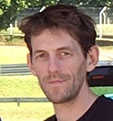The Etape du Tour is, as you're probably aware, a chance for amateurs to ride a stage of the Tour de France - typically one of the tougher ones with lots of climbing. This year it was the Tour's stage 18 from Briançon to the summit of the famous Col d'Izoard.
Over 12,000 cyclists assembled in Briançon for this year's Etape du Tour. I read somewhere that around 1,000 failed to finish - a figure that doesn't surprise me. I finished 2016th out of 11,248 - in the top 18% of finishers, which is fairly respectable for someone who crashed, who's only ever ridden in the mountains once before, doesn't like hot weather and was trying to make the most of the scenery. As ever, I was trying to find the balance between a respectable time and actually appreciating what I was doing and taking in the scenery.
I had a 50/34 chainset and an 11-28 cassette. I knew that would be 'enough' but in an ideal world I'd have preferred a 30 or 32 on the back as I prefer a higher cadence. My preference for higher cadence however doesn't outweigh my preference not to spend good money on a cassette just for one ride.

The day before the Etape we (that's myself and Oisin, the editor) had planned to ride the Col du Galibier which is just 20 miles or so from Briançon. The previous day's travel via Milan and Turin had meant eating bad food on the go, and I felt terrible on the Saturday morning. I was also experiencing recurring knee pain that had started bothering me recently.
The route to the Galibier was via the Col du Lautaret, a long, slow easy climb, but we were into a block headwind the whole time and there were a lot of cars on the road. It took around 95 minutes to reach the summit of the Lautaret from Briançon and we decided that'd do for the day.
The way back was thirty minutes at an average speed of 48 km/h which was a lot more enjoyable. I wasn't feeling optimistic about the Etape and spent the evening pummelling the area around my right knee with a massage ball.
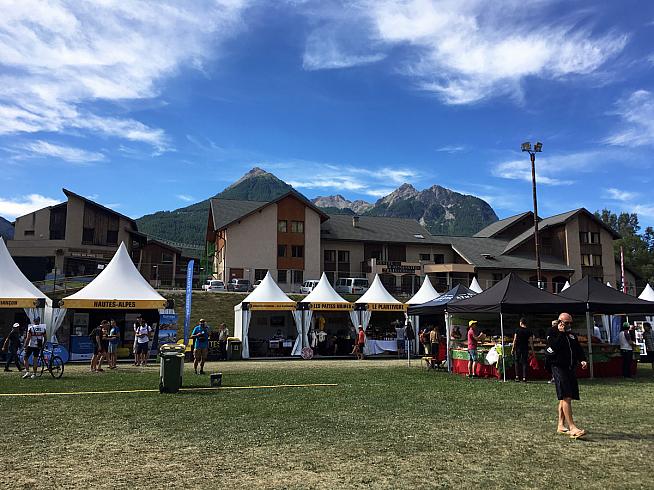
We'd visited the Etape village twice the day before the ride - once to register in the morning and later in the day after our ride and lunch for a proper look around. It's a great place with a lively atmosphere and you're really part of an event.
It's mainly a marketplace for big brands - the likes of Bianchi, Trek, Canyon, Look and many more all had stands there. Beyond that there's a few bits and pieces you can do including watching the Tour live on a big screen and a velodrome game where you pedal on a turbo trainer to move riders around.
Of note was the large Mavic stand with a vintage service car and bikes on show, a particular gem being Chris Boardman's prologue bike. The famous Didi the Devil (who we'd seen hanging around the street the night before with a bottle of wine in his hand) was also present and getting in the mood.
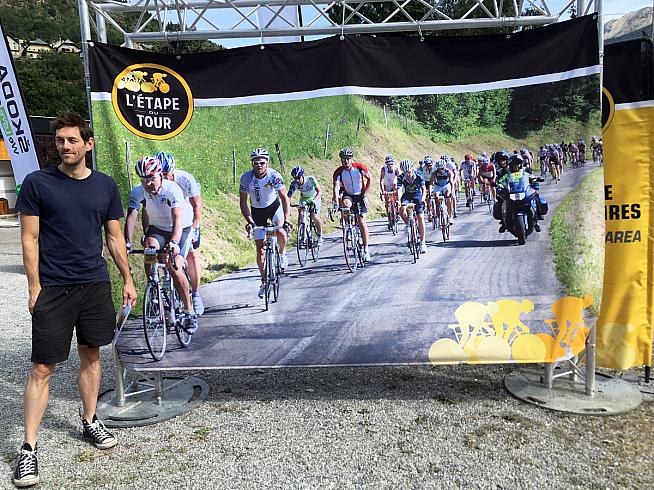
We swung by the Rapha stand to look at the official Etape gear and were very kindly provided with an official event jersey each for the ride, so that was the choice of jersey for the day sorted. It was a 'lightweight' jersey and, well, it was very lightweight. It looks so nice and lightweight in fact that I was naughty and decided I wouldn't be pinning my number on the back if at all possible (I got away with it).
A big plus of the village was that if you wanted to buy anything you weren't getting stung for 'show' prices - everything was at the sort of price you'd pay online with some extra reductions for end of line stuff here and there.
Sign up was a fairly painless process helped by a huge number of staff, all in Rapha T-shirts. To ride you need your forms printed and a valid medical certificate. Word of warning, you cannot forget forms or just blag it - all the forms are checked very, very carefully before you get your race pack (which contains all the usual bits plus a nice Rapha Etape wallet/phone holder and some topical recovery gel and a multi-tool - because the type of cyclist who rides the Etape won't have half a dozen of those already).
The number that goes on your back and the one for your bike has your first name and the flag of your nationality on it, which I thought was a nice touch. Also there was a huge printed board listing every participant - another nice touch.
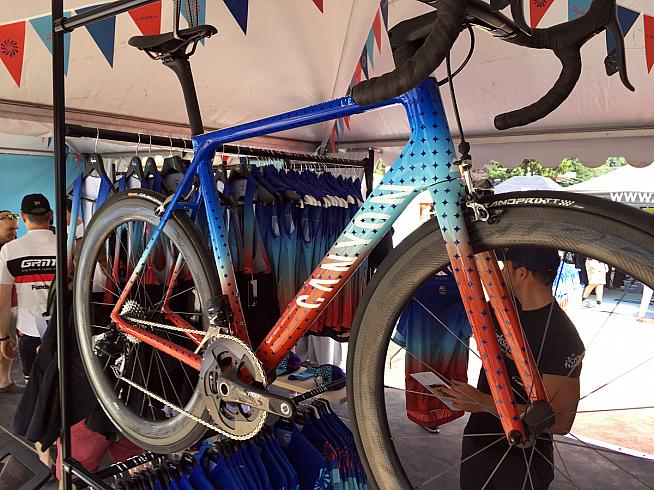
Etape Day - the start
On the day itself the slick organisation manifest everywhere else wasn't quite there at the start. It was very confusing where we were meant to go for our starting pen (a dozen of them sorted by rider number) and we had to climb a sheer grass verge at one point. Once we found our way to the starting pen it was all pretty painless with very little waiting around, and we were off. Fortunately I was feeling much better than the previous day and was ready to go.
My nutrition strategy was a bottle of sugar water, bottle of water, two bananas, some dates and roasted and salted cashews. That would get me through at least the first 100km without any trouble, and then I'd see what the food stops had to offer.
My troublesome knee flared up pretty quickly forcing me to stop and insert a Specialized shoe wedge I'd brought just in case (it changes the angle of the foot inside the shoe which should stop any lateral knee movement caused by pronating). Mercifully (for myself and you, the reader) this pretty much resolved things and it didn't bother me again so I don't need to mention the knee again.
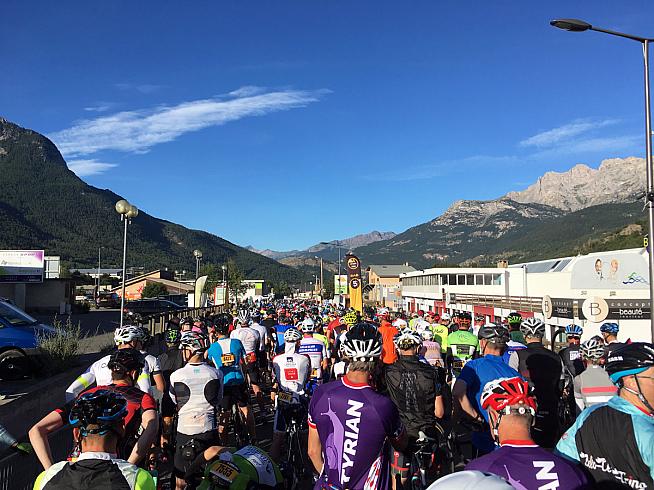
Setting off it was pretty busy but nowhere near as bad as I expected. For the most part there was plenty of room to pass - the organisers had got the balance right of how to stagger the starts. The only issue came when hitting a descent - I managed to lock my wheels up at one point as a very cautious young lady wanted to take the corner far slower than I thought anyone might deem appropriate.
The scenery was all very pleasant but nothing much to report (when watching the stage of the Tour itself I didn't recognise any of it but it was very nice). Because of the climbs to come everyone was preoccupied with them so, whilst there was a race going on somewhere at the front, most people were holding a steady pace.
The route looked heavily back loaded with all the climbing at the end (though was actually all uphill from 65km). However, the hugeness of the two climbs at the end made it easy to overlook the earlier climb of the Coiffees, which is a bit of a climb in its own right (3rd category). This nicely split up the field. Speaking of the field, the national flags on race numbers (and not just the pasty flesh and panting) made it clear there were loads of English riders around.
On the French train
I had latched onto a group of quick French riders for a while which led to good progress. Due to the variety of abilities things spread out a lot on the climbs and it was hard to pass at times. At each ramp up I found myself at the front of our little group and the riders behind me shouting at those in front to please move to the right. At this point I realised it might have been a handy phrase to have learnt in advance. Unfortunately I got a bit caught up in traffic on a descent and lost my sprightly French group.
I skipped the first food/water area and held on for the one at 100km. It was absolute chaos. There was nowhere near enough room for all the riders and their bikes. Bikes were being leaned wherever possible and people were piling in grabbing what they could like the apocalypse was coming. There was bread, oranges, bananas and some sports drinks and bars.
Although it was chaos, there didn't seem to be any danger of the supplies running out. I grabbed what I could and got out of the madness as quickly as possible.
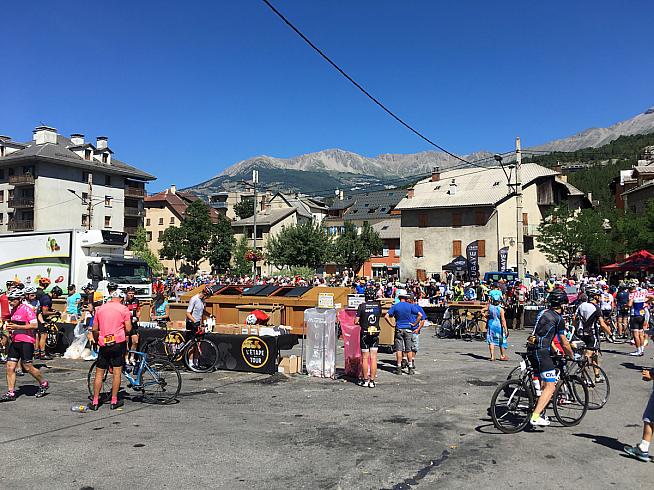
There followed some beautiful roads, next to a river, between mountains, through tunnels, etc. It's quite sad that I wondered how long it would be before my Garmin lost signal in the tunnels. If you wanted the full Tour de France experience, this was it. The scenery was awesome: short of a waterfall and a rainbow being added in, it's hard to imagine it being any better as you zip between mountains at very, very ordinary speeds.
All in all I was feeling pretty good when we got to the two final climbs. Before them I'd stopped off to top up the water and grab more fruit. I knew I'd left plenty in the tank and would be capable of finishing no matter what. It was warm at 25 degrees but pretty breezy and the scenery continued to be amazing.
An overcooked corner
At 116km the first climb really kicks in, the Col de Vars. This was a steady affair, mainly due to apprehension for what would come next. To blow up and fail on the Izoard was unthinkable so caution was needed here. I did the Col de Vars at what Strava tells me was 73% intensity. Just shy of an hour at 204 watts (3 w/kg), at a speed of 14km/h, average cadence of 73. A good measured effort, I thought.
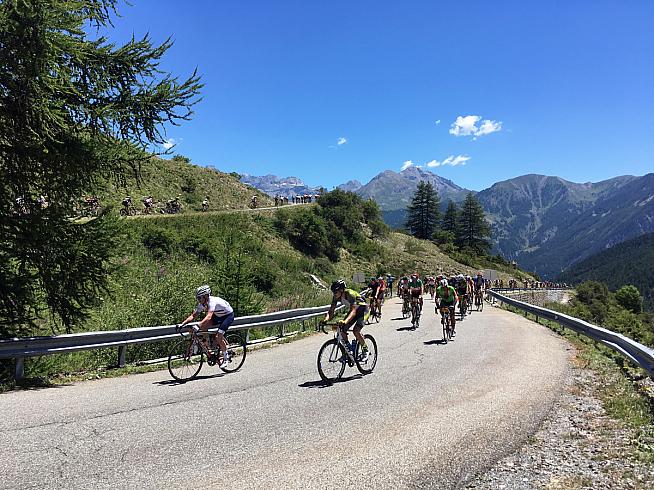
There followed a descent of 20km. I found myself being one of the better descenders overtaking lots of people. I did get held up a few times though by slower riders and this can be quite sketchy as you pick up so much speed. You find that some people really, really slow down - way more than necessary, so it's very hard to judge what line they'll take. After getting round a few riders I finally had some clear road and then managed to overcook a very tight turn.
I came around the hairpin, leaned left to sweep around and then quickly realised I wouldn't make it. In front of me was gravel and a wooden fence protecting me from a drop down into some vegetation. I grabbed both brakes, leaned back and tried to hit the fence sideways. So far as it's possible for a crash to be a success, this was one.
I slammed sideways into the fence as my bike flicked up between my legs and I managed to land half on top of the fence and sort of upright without letting go of the bike. I instantly got back up and another rider asked if I was OK. I said yes because, well, you have to say that.
The damage: a grazed forearm, a badly grazed calf, a grazed back and a tiny rip in my shorts. I'd nearly gone clean over the fence - I didn't stop to check how far the drop down was, but I'm fairly sure it'd involve broken bones if I'd gone down there.
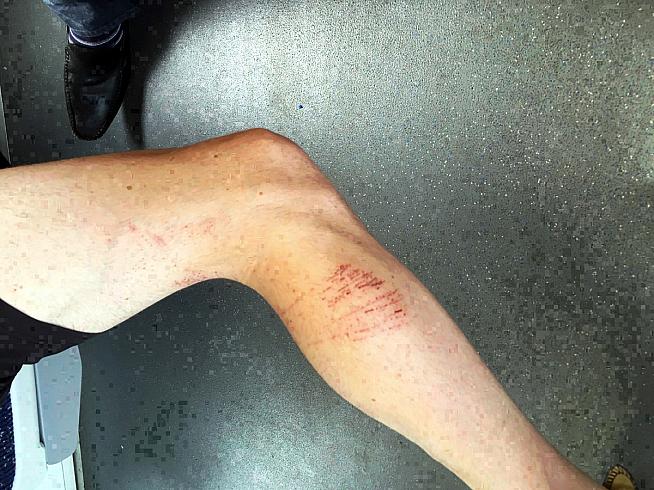
My leg stung quite a bit and was bleeding but I had no plans to slow down and descended just as before. Later on I had noticed someone wince at the sight of my leg. Needless to say I soldiered on like nothing had happened. I'd also spent a lot of time reaching round to my new Rapha jersey expecting it to be ripped. Happily, despite its lightweight minimalism, it survived with only the merest scuff on the back.
It wasn't until the next day I realised I was taking home quite a bit of the roadside barrier in my arm. Fortunately I'd kept the safety pins to attach my race number, and was able to pick out the splinters on the flight home - you have to make your own fun on Easyjet.
The Col d'Izoard
I grabbed a few bits and some water at the 151km food stop. The Izoard finally arrived. It took the top pros about 45 minutes to climb it (four days later in the stage proper). It took me 1 hour 40. My cadence for it was a paltry 59rpm and power 162 watts for an average speed of 8km/h. I could have done it a fair bit quicker, I was never out of breath, never really struggling that much, but my concern was that any real attempt to push on would lead me to blow up completely.
The climb feels never ending. I spent so long riding at the gradient I started to wonder if I was still climbing or if it was actually flat ground and I was just really slow.
I made the mistake or looking up just to torture myself. It's quite a sight to see the riders zig-zagging above you in lines - a lot like the classic game, Lemmings. Looking up presents a bit of an optical illusion because the other riders look like they're on really, really steep ground but they're actually on the same gradient you are. Looking down at the serried ranks of Lemmings suffering what you've already conquered is dedinitely a morale boost though.
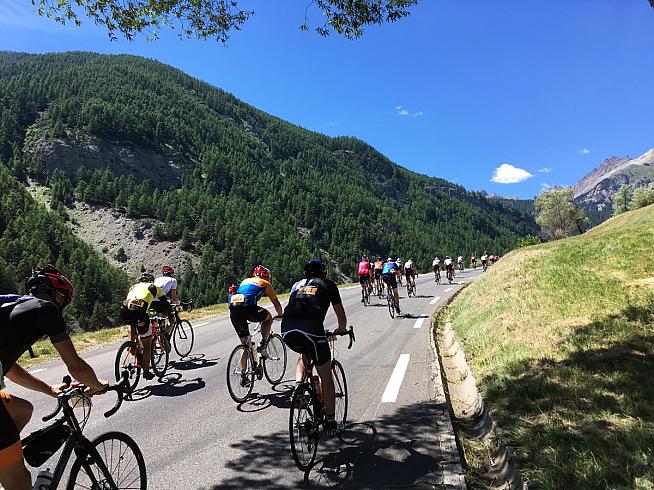
Along the Izoard you pass little hamlets or resorts - including a few places you could stop and buy food, which were pretty tempting. Spectators were already in their camper vans for the Tour. Many offered to pour water on you as you passed, I was happy to receive it all over my boiling head - there was probably steam.
One farmer had directed a sprinkler across the road and the ice-cold droplets on my back were bliss. I can't say I really noticed any issues with the altitude. The effort of turning the legs was the only thing on my mind, and getting to the top.
Amongst the punishment, out of the blue there's a 500 metre descent. For a few moments the legs come back to life and you feel relief like everything's fine and your legs aren't that tired. But then it's straight back to the previous gradient and you're wondering if that rest was a help or a hindrance as the legs are back to grinding.
A lot of people were off their bikes pushing, no one managed anything like fast - just different levels of slowness. I wanted to get off, to stop, to rest but I knew that wasn't an option and ploughed on. Along the way there were 'motivational' signs on the kilometre markers: "Nibali would attack here" and "Legs say no head says yes" were the ones I remember.
The kilometres took an age to roll down until the final one. But I don't get beaten by climbs and wasn't about to start here - no matter what I'd suffer on, remembering to sip water, wiping the stinging sweat from my eyes.
Rounding the final bend and seeing the finish was relief (and there's Didi the Devil again, looking excited). It had been a hard day at well over seven hours of riding stopping as little as possible. There was some whooping around and shouting - I wasn't taking it in, I just needed to sit.
The summit
Loads of riders sat on a grass verge at the top of the Izoard enjoying a cup of what was being handed out (water or coke from what I remember). Unfortunately the end wasn't quite the end. That's where the finish line was, but the event village itself was back at the start - 20km away. 20km of fast descending that needed to be negotiated by tired bodies and minds.
I sat for about 10 minutes with my head down trying to refocus, gather what was left of my energy reserves and get ready for the descent. I was feeling pretty fatigued as you'd imagine, but had managed to keep myself from going into full nausea mode. You didn't get a finisher medal unless you went back to the start, nor any food. More practically, all the roads were closed so you had to ride the 20km back and couldn't call a taxi in desparation.
I hit the descent from the Izoard pretty quickly then nearly cried when the descent became flat and even ramped upwards for a few metres - everyone ground to a halt, the feeling of free-flowing speed snatched cruelly away and back to the suffering you thought you'd overcome.
Taking thirty-odd minutes to go down something that took over a hundred minutes to ascend feels quite strange but puts things into perspective. Then it was back to the Etape village. Quite often after a very long ride, I want to sleep immediately but I had the wherewithal to pop my bike in the storage area and find out what was in the bags I saw people leaving the village with. I was also following the 'pasta party' signs in spite of little appetite.
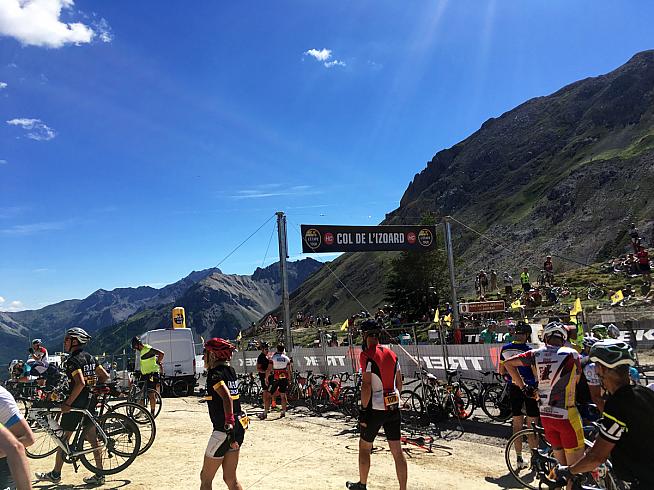
The pasta party disappointed, massively. I was heading towards what I thought would be trays of pasta in tomato sauce being dished out - just the thing for a tired rider who needs some proper food but can't stomach too much of it. Instead I got a cardboard pot of pasta in my finisher's bag. If you don't like meat and/or cheese you're fresh out of luck because it's all chucked into the pot and handed over - no options available.
Elsewhere in the bag was a pack of crisps, some baby food (apple puree), some very stale looking bread and possibly some other bread-based snack I forgot about. They also handed out bottle of water and cans of coke.
For those with an appetite for the pasta, its worth noting that there was plenty of everything being dished out, not rationed, not 'tight'. A very nicely put together event I thought, and something that would stay in the memory forever.
I sat down for a bit, ate some of the bagged food and decided it was too hot to hang around and headed back to the hotel. Forcing down what food I could from what little I had, I lay on the bed, closed my eyes and didn't re-open them for ninety minutes.
Epilogue
Four days later the Tour rolled through the same stage. 4:45 or so was the best finish time compared to my 7:19. The fastest time on the Etape was around 5:15 (by someone in a 'development' squad, i.e. a future pro). I imagine there was a heck of a strong peloton from the lead pens and the Strava time shows no stopping by the winner (I don't know if they share water and food, but I wouldn't have been able to carry enough water for the whole ride).
The aerial shots of the area on TV are stunning and you realise how much you missed being on the ground, burying yourself - lovely though it was.
On reflection, the Etape was brilliant with only the very slightest things I'd change. Closed roads, a huge 'event' atmosphere and all kinds of cycling stuff around. Just knowing you're riding on iconic roads like the Izoard is pretty special. The roads sweep and swoop through spectacular passes. At the end you've really done something tangible, not just suffered a sportive but done an actual stage of the Tour with some famous mountains to boot. It certainly puts into perspective what the pros do when there are a couple of mountain stages in a row.
Personally, it was interesting that my average power was almost identical to that I'd done a month ago at the Morzine sportive (which was a little shorter and had slightly more climbing, albeit a bit more spread out). The Etape itself was done at an average speed of 25km/h and 180 watts (2.7w/kg). The 20km descent at the end was done with just 56 watts and an average speed of 40km/h which, bearing in mind the corners and hairpins, really demonstrates just how huge the Izoard is. My top speed for the day topped out at about 78km/h - I was spinning out my 50/11.
If you haven't done the Etape it's well worth it. It's hard to imagine there's anything else out there that can match it for the prestige, spectacle and all-round feeling that you're part of something big - in fact the biggest, in cycling terms: you're part of the Tour de France.
0 Comments

